MAPUTO BAY AND SURROUNDS
Compiled by Louis-John Havemann
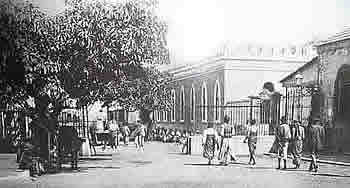
HISTORY OF DELAGOA BAY - LOURENCO MARQUES - MAPUTO:- OLD HARBOUR PHOTOS
This is the capital city of Mozambique with a population of about two
million people and a large harbour.
For further history of Maputo go Maputo Bay and Surrounds.
Under Portuguese influence, Lourenco Marques became one of Africa’s
most beautiful and fashionable cities with a cosmopolitan continental
atmosphere, pavement cafes, and a thriving tourist industry.The famous
Polana Hotel was one of the tourist social highlights and the nightclubs
pulsed with action until the early hours.
The civil war in the 1970s and 1980s changed all that. When peace finally
came, the once beautiful Mozambican city was in terrible disrepair.
Thousands of immigrants crowded the buildings, litter and filth lay
everywhere and major services including water and electricity were non
existent.
Signs of the struggle still show by the bullet holes and marks
on the walls of many buildings of the city. These damaged buildings
include not only private homes but also some markets, museums, palaces
and even synagogues.
The brighter side is that the city is being rebuilt, with the hope that
it can again capture it's attraction and success as a very popular tourist
destination.
Today the city is slowly recreating some of its former glory. The tourists
are once more visiting the five-star Polana Hotel, with its view over
the harbour.
It is bustling port city, with a population of about two million people and beautiful avenues of trees of various colourful types.
Maputo lies only 100kms from it's neighbours South Africa and Swaziland
There is a wide variety of tourist accommodation and destinations available to choose from and within the Maputo surrounds, can be found tourist or holiday destinations to meet anyone's need. Luxury hotels cater for the wealthier tourists and visitors, but there are a host of holiday accommodation and backpacker venues to choose from.
There is a ferry to serve those tourists or people who wish to cross to Catembe and there are various means to get to Inhaca Island and the tourist, holiday accommodation establishments and fishing destinations that are on offer there.
Maputo, formally known as Delagoa Bay and then as Lourenco Marques, or LM, was a very popular tourist destination until the early 1970s. For detailed History CLICK HERE
As a result of the devastating civil war that Mozambique went through for many years there are ugly reminders and scars on Maputo's buildings, including some of the markets, synagogues, museums, palaces, and private homes. These scars are a reminder of the violent civil war and devastating struggle that Mozambique had to suffer through until the 1990s. It became the poorest country in the world and is slowly rebuilding it's WRECKED INFRASTRUCTURE and regaining it's popularity as a tourist destination and holiday venue. Gradually tourists are revisiting the places of interest. See Maputo Places to see page.
Maputo's night life is renowned but care has to be exercised when partaking of the pleasures of the flesh because of the very very real danger of HIV/AIDS.
The harbour contributes in no small measure to Mozambique's economy and exports include, coal,cotton, copra and sugar.
The Mozal Aluminium Smelting Plant is the result of investment from both South Africa and Mozambique and is one of Mozambique's top foreign exchange earners.
HISTORY OF DELAGOA BAY - LOURENCO MARQUES - MAPUTO:- OLD HARBOUR PHOTOS (Delagoa Bay was thought to have been derived from "a Goa" and then to to "Goa", which is wrong. It is generally accepted to have been derived from "lagoa" which means lagoon.) Maputo was a Ronga chief, and Lourenco Marques was renamed after him when Mozambique attained it's independence. Maputo controlled the area around the Bay to the south.
Lourenco Marques was a Portuguese trader who was sent from Mozambique Island, after 1544, to investigate two rivers to the south. These rivers are accepted to be the Ncomati and the Limpopo. He came back with the report that beads could be traded for ivory and also that there were numerous herds of elephants in that area.
Throughout the 16th to the 18th centuries the Portuguese sent trading vessels from Mozambique Island , south to Delagoa Bay to trade for ivory from the Ronga people who lived around the Delagoa Bay area.
Because of the relatively cruder sail rigging of that time, the traders came down south in the months of December, with the trade winds and waited for the trade winds to change, round about June, in order to be able to sail back to Mozambique Island.
The Portuguese did not really venture far inland during these times and as such did not play much part in the political control of the hinterland and adjacent coastal areas, which was firmly under the control of the Ronga people.
This early trade was also not free from dangers and troubles however.
There is a report of a Portuguese ship that was raided and looted because of crimes that the captain was alleged to have committed against the Ronga tribes. Chief Nyaka (after whom Inhaca Island is named) put to death a Catholic priest and some other Portuguese sailors who killed one of his brothers.
Britain was a major sea power at the end of the 16th centaury and as a result, British ships started trading with the Ronga tribes and called in at Delagoa Bay. which created more strain on the Portuguese and Ronga relations. The Portuguese trade beads and other trade goods were considered inferior to the British goods and the British also paid better barter prices for their trade commodities.
This,as well as piracy, led Portugal to withdraw from sea trade and rather send trading parties down by land, from northern Mozambique.
At the beginning of the 18th century Delagoa Bay was considered to all intents and purposes an open trade port, but the Ronga people were firmly in control of the hinterland.
Photos courtesy of Artur Rocha
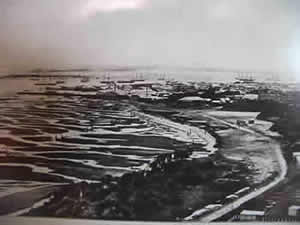 |
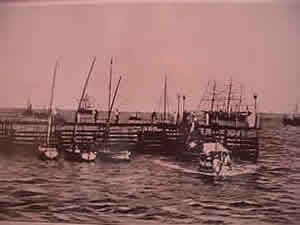 |
Lourenco Marques from
Ponta Vermelha (Date unknown) |
The Passenger Landing Pier
(Date unknown) |
Then entered the Dutch.
The Dutch had established a settlement at the Cape of Good Hope in 1652, as a re supply station for ships en route to the East Indian Spice countries.
Their main focus was on growing food supplies and re supplying ships of The Dutch East India Company and establishing their Cape settlement, so very little attention was given by them to exploration of the east coast of Southern Africa.
When reports of British successes reached them there was a renewed interest in trading with the locals along the eastern coast. In 1688 a Dutch ship, Noord, reached Delagoa Bay and found that the British were well established there and that the Ronga people were amenable to trade relations. It took a further thirty years before the Dutch did anything constructive to establish themselves in Delagoa Bay.
Interest in the legendary Land of Ophir or Mwene Mutapa (Monomatapo) and the vast riches of gold
was the catalyst that spurred the new interest of the Dutch East India Company. As a result they established a permanent settlement of over 100 people at Delagoa Bay.
The relations with the Ronga people were always on an uneasy footing. The balance between trading and having to always be wary of attacks did not help in the beginning of the Dutch stay.
They also had lower quality beads and apparently the Ronga people did not like the colours of the Dutch
beads.
There were superior copper goods available from the interior, so trade was not all that successful. The soil around the Bay was not very fertile and the Ronga were not willing to supply food in trade,so the people living in the settlement were emaciated and ill fed.
In 1722 a serious setback hit the Dutch settlement. Two pirate ships entered the Bay and raided the Dutch settlement and imprisoned some of the Dutchmen, while the others were forced to flee and hide in the surrounding bush.
After these pirates had looted the settlement, they then proceeded to trade with the Ronga and to make matters worse, they paid a lot more for ivory, than the Dutch were paying.
In 1723 a British ship arrived and was most surprised to see a big Dutch presence at Delagoa Bay.
This ship the Northampton was supposedly bringing back two Ronga princesses who had been in slavery.
The Dutchmen informed the British that only Dutch East India Company ships were allowed to trade in the Delagoa Bay region.
The British withdrew beyond the range of the Dutch cannons and ignoring the Dutch totally, proceeded to trade with the Ronga. They also paid the Ronga much higher prices for ivory and bought over five tons of ivory.
Later on in the same year traders from the interior brought gold dust, which was the first gold seen by white traders in the Maputo region. These traders from the interior also had sophisticated scales to weigh the gold dust and showed themselves to be experienced in the trading of gold. The end result was, that whatever the prices were, that the inland traders demanded, they got paid.
Labour relations between the Dutch and Ronga, were always a problem and after many negotiations and strikes, a new salary scale was agreed to. A man was to be paid one and a half bundles of beads per day and a woman received quarter of a bundle per day. Two bundles of beads were the equivalent of one head of cattle.
Because the Ronga controlled the food supplies and more importantly the trade goods they could demand what they wanted of the Dutch. This caused the Dutch to try and bypass the Ronga as middlemen and attempted to trade directly with the traders from the interior. This led to the first recorded confrontation between white men and the local black people in South Africa. Frances de Kuiper in 1725 led a party into the interior and at what is now known as Gomondwane in the Kruger Park there is a plaque to mark the spot of this attack on the Dutch party.
This manipulation by the Ronga of the Dutch by threatening all sorts of other trading relationships with the British for instance led to the Dutch wising up. They eventually began paying higher prices to lessen the threat of competition
They also managed to overcome the problems of fever (malaria) and the poor soils. The Dutch also undertook the sounding the depth of the Bay and exploring the rivers in the area.
However the Dutch failed to realise the extent of the Ronga people's commitment to maintain their control over the area they had.
They did not understand that the Ronga refused to allow themselves to be controlled. This was manifested in the clashes of the Ronga between themselves, which led to the equivalent of a civil war within their tribes.
This inter tribal in fighting led to serious consequences in that, trade and contact with the interior traders was severed. Nobody could pass through the Ronga areas without being robbed and even although the Dutch tried to pay the traders of the interior, damages for their losses, these traders were robbed again on their way home.
The situation became so serious that the Dutch became involved in the Ronga inter tribal wars. In 1729, 32 Dutch soldiers and some civilians were killed. Their firearms were taken by a Ronga patrol that was fired on by the Dutch.
This led to the local Commander requesting more support in troops, from the Cape, to protect traders in Delagoa Bay.
His pleas fell on deaf ears. The Dutch found out that a lot of the gold dust had been salted with sand and so they did not purchase anymore gold from the hinterland traders.The supply of slaves had come to a halt after rumours went out that the Dutch in the Cape ate the slaves. Ivory supply was falling and with the poor soils they could not attain self sufficiency in food.
The Ronga food supplies were a manipulation lever used against them.
"Lords Seventeen" of the Dutch East India Company, who were the ones paying.
The Delagoa Bay project had cost the Dutch East India Company ten times more than they had earned. Relations between the Dutch and the Ronga had deteriorated to such an extent that the Dutch could not leave their fort unless accompanied by men at arms.
In 1730 the Dutch pulled the plug, cut their loses and closed the settlement and left.
Swazi:-
There is a story told of how a small revolution developed to displace King Sobhuza of Swaziland, whilst his army was away on a raid. One of his vassals named Moya attacked the capital but Sobhuza fled into hiding in the Hlatikulu Forests. From here he sent word for his army to return as well as sending for European reinforcements at Delagoa Bay. Some Portuguese traders came to help with their guns and so it was that the first White men arrived in Swaziland. Sobhuzo regained control and rewarded the traders with cattle and they in turn are reputed to have given Sobhuzo the first maize (corn) seeds known in this eastern part of Africa. Maize or corn was not indigenous to Africa and these seeds came from the Portuguese colony of Brazil.
Austria:- There is another country that became involved before the Portuguese finally claimed Delagoa Bay back for themselves.
With the withdrawal of the Dutch the British who were ever present caused, in a round about way, another country, Austria, to become involved in Delagoa Bay.
A British trader with a rather un savoury reputation, named William Bolts, had been fired by the British East India Company for shady and unscrupulous trading deals.This resulted in so many complaints, that the Company had no option but to get rid of him.
He was arrested and deported back to England, where he set about to establish a trading company, that would be in competition with the British East India Company.
He needed financial backing for this and found that he was rejected by most financial entities in Europe, who knew of his reputation.
He finally managed to ingratiate himself with the Emperor of Austria's wife, Maria Theresia. He obtained funding from Austria and started the Ostend East India Company.
Painting of Emperor of Austria's wife, Maria Theresia.
|
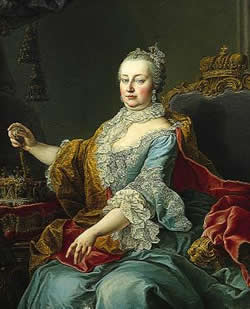 |
The Portuguese, who were unable to physically occupy the Bay, attempted to try and combat British competition, by
declaring the Bay closed to any nation other than Portugal. They had no chance to succeed in this because the Ronga declared the bay open to any trading nation and refused to abide by what the Portuguese tried to force them to do.
In this they were fully supported by the British, who were more efficient traders and who paid better prices.
The British had no desire to occupy Delagoa Bay, nor get involved with the local politics. All that they were interested in, was the huge profits in ivory trade with Europe and to promote this they also traded firearms to the Ronga to assist them in obtaining ivory.
In 1773 William Bolts took the first group of people to Delagoa Bay and followed it up in 1777 with 150 people to settle in Mozambique and declared the Bay Austrian territory.
The Ronga still remained in control despite Bolts' efforts.
Chief Nwangobe had defeated his rivals in the area (Madommadom, Machavane and Nyaka).
One of chief Nwangobe's sons, was Maputo after whom Lourenco Marques was named at independence. Maputo controlled the area to the south of the Bay during the 1770's.
One of the biggest problems to Bolts at this time, was the inability to understand that the Ronga were not, nor ever had, considered, giving up control and ownership of their land. The Ronga believed that they had only granted Bolts the right to use the land, according to their discretion. They considered the Austrians to be under their laws and subject to their chiefs.
Bolts on the other hand, believed that the treaties with the Ronga allowed him passage along the rivers and control and title to the land specified in the treaties.
This led to future problems. The Austrian commander, Andre Pollet had been given instructions to ensure the safety of lives,maintain cordial relations with the Ronga, even if meant having to endure provocation and insults.
This misunderstanding led to confrontations and in 1778, some of the Austrians were forced to seek refuge on one of their ships because of hostilities. Some of the soldiers returned to the fort for supplies and were seized by the locals and put to death.
The British ignored all Austrian attempts to enforce authority and carried on trading and paying higher prices to the locals for ivory.
Bearing in mind that the garrison were emaciated because of poor food and weakened by disease, thus they were seen as no obstacle, to any sort of force that was prepared to attack them. This was a bonus for the Portuguese.
The Portuguese were reticent in confronting a major power such as Britain, but a private and weakly garrisoned trading company, was an entirely different matter.
The Portuguese had always been determined to occupy Delagoa Bay and to control the trade and exploit the local people including the Ronga. Therefore on the 30 March 1781 a Portuguese force from Goa under the command of Viciente Godhino de Mira, landed at Delagoa Bay, attacked the Austrians. He razed their buildings and raised the Portuguese flag over the Bay. This was to be a brief 14 year period.
The Ronga repeatedly told the Portuguese, as well as other foreigners, that they the Ronga were the custodians of the land and that they allowed foreigners to stay there as their guests and if this didn't meet with their approval,then they could leave.
The Ronga people suffered serious results from the Portuguese efforts to keep Delagoa Bay under their sole control. They were in a large measure prevented from trading their goods to the best of their advantage. Their trade relations with the interior people, with whom they traded, suffered and they did not have answers to combat this negative effect on their trading ventures.
Relations between Ronga and Portuguese were further strained by the attitudes of successive Portuguese governors.
Delagoa Bay governors:-.
The first governor was Joao Henriques de Almeida. He fled the scene in fear for his life after supplying watered down rum to a certain chief.
In 1784 Pedro Testevin the new governor and the force under his command occupied the Bay. The Locals complained about his cruelty and his authority was flouted and defied.
Portuguese authority had become non existent and by 1790 various trading nations were trading freely, especially in ivory.
There were French whalers who were buying their supplies direct from the Ronga, despite Portuguese laws forbidding this.
During this year the Portuguese at the Bay under the command of Silva Pacheco mutinied, because they maintained that the governor was stealing government money and buying ivory for his own account.
In 1796 during the month of October a small fleet of French ships arrived and demanded the surrender of the Portuguese garrison. After the surrender the fort was looted and set alight. For the next three years Delagoa Bay was unoccupied by any foreign force.
The Portuguese returned to Delagoa Bay in 1799, but again it was a very weak ineffectual presence, ignored by all sea powers and their ships.
In particular a new group had appeared and this was the whaling contingent. American and British whalers were making frequent use of the Bay and fishing and mooring there. Portugal therefore decided to establish a whaling factory in Delagoa Bay, under the management of a Portuguese by the name of Caldas.
He fell out with a Ronga chief and was captured and killed. Portugal did nothing to punish this act and so lost the respect of the locals, appearing to the Ronga to be too weak to enforce any law and order.
Delagoa Bay had, up to now, always been a minor settlement of Portugal's colonial empire, with far more importance being given to the northern Mozambique settlements like Sena, Tete, Inhambane, Sofala, Quelimane and of course Mozambique Island.
The unsuccessful trading at the Bay resulted in all the frustrations of the previous attempts and finally in the end the last remaining Portuguese trader at the Bay, Miguel Lupe de Cardinhas, became governor.
He mistreated the Ronga people and whilst returning from a flag raising ceremony, the locals attacked and killed him.
The next governor Teixeira, suffered the same fate and was attacked and killed.
At the lowest point of Portuguese authority, Xavier Schmidt von Belliken arrived in the Bay to take up the governor's post.
He tried very hard to restore Portuguese authority. His means of doing so, (especially with the Ronga chiefs, who consistently refused to enter into treaties or respect Portuguese rule and help with building of forts), was rebelled against.
He was duly replaced by Dionisio Antonio Ribeiro.
Up until now the various Portuguese governors were used to exploiting their positions for their own profit and they were able to do this, because they could virtually act as they liked.
When the Companhia do Comerciao de Lourenco Marques e Inhambane was granted the monopoly of trade in Inhambane and Delagoa Bay, relations between the Company and the governors worsened.
Complaints against Ribeiro by the soldiers under him, reached the Company.
They reported that Ribeiro was sending them on slave hunting expeditions at Portugal's expense.
The Nguni Factor:- Shaka the Zulu king embarked on a military course that was to impact on the history of Southern Africa.
These military campaigns led to the displacement of numerous tribes in the region. This displacement is known in history as the, "Mfecane".
When Shaka had finally defeated his strongest opponent Zwide , Chief of the Ndwandwe faction in 1819, two of Zwide's generals fled Zululand,which lay to the south of Mozambique.
The one general, important to this history, was Soshangane. After the 2nd Ndwandwe war when Zwide was finally and decisively beaten, Soshangane fled with a large group of his followers to Southern Mozambique.
This caused confrontation between the Ngunis from the south and the resident Ronga and by 1835, the Ngunis were firmly in control of Southern Mozambique.
This strong influence lasted until the defeat in 1879 of the last great Zulu king Cetswayo, by the British. Intermarriage had blurred the distinctions by then and they became known as the "Shangaan" people after Soshangane.
Ribeiro tried to undermine and negate Britain's strong trade position, by making friendly overtures to the Zulus under their King Dingane. Dingane had with two others, assassinated his half brother Shaka and was now on the Zulu throne.
At first this went well but when Ribeiro refused Dingane more trade goods by claiming that his storerooms were empty, Dingane ordered a ban on Ronga trade goods.
This led to the Ronga attacking the Delagoa Bay fort. Ribeiro fled to an island in the vicinity but when he later emerged, he was captured tried and executed.
The head of the Portuguese company, Jose Nobre, testified against Ribeiro which contributed to his death.
The Ronga had amongst other charges, accused Ribeiro of sending people into slavery and of trying to seize their lands, so they continued their fight against Portuguese land control aspirations, until the last years of the 1890's.
A Ronga chief called Gungunyane fought against the Portuguese during the 1890,s and gave refuge to two minor Ronga chiefs.
Chiefs Mahazul and Matibejana laid siege to the fort in the Bay in objection to hut taxes. They were defeated and were were granted protection by Chief Gungunyane.
Portugal demanded that they be handed over and Gungunyane refused.
A military force under Antonio Enes was sent in 1895 to subdue him. As was being proved in Africa, the spear was no match against fireams and likewise, Gungunyane was captured and taken to Lisbon, where he was paraded through the streets, then exiled to the Azores where he died.
In 1897 Gungunyane's chief advisor rebelled against hut tax and cattle confiscation. He too was defeated, but commited suicide rather than be captured. This ended the Ronga resistance to Portuguese rule for nearly 70 years.
In 1897 Lourenco Marques was named the capital of Mozambique or Portuguese East Africa as it was then known.
Tribal disunity had allowed Portugal to divide and rule. There now followed what was to be Portugal's final undoing.
The Portuguese in !873, placed all black nationals in Mozambique under a common identity as "Indigenas" or black nationals.
This culminated in a black population identity, outside of ethnic and tribal differences, which provided a unity to finally overcome Portuguese colonial rule. |
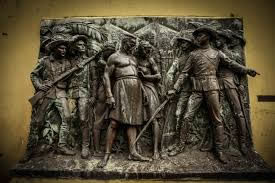 |
MACMAHON OR 2M BEER
In 1869 however the Portuguese and the Boers signed a treaty which recognised Portuguese rights to Mozambique and agreed to the building of a road from the Transvaal Republic, through to Delagoa Bay.
Transport riders made the journey from Delagoa Bay to Barberton and Pilgrims Rest and later Pretoria by ox wagons, transporting vital supplies to the interior. They suffered many hardships, running the risks of malaria tsetse fly and lions.
The British contested this agreement on the grounds that in 1823 the British flag had been raised on the southern shores of the Bay and that Delagoa Bay had been an open port.
This land claim ended up in the lap of the French President, Marshal MacMahon, to rule on. MacMahon ruled in favour of the Portuguese in 1875 and one of Mozambique's beers, "2 M" or "Dos M" still bears his name. There was a square named in honor of him, Pracas dos MacMahon, which was changed to Pracas dos Trabalhadores (Worker's Square) at Independence
Photos courtesy of Artur Rocha.
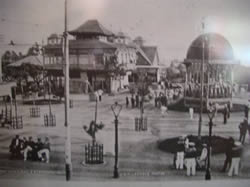
Lourenco Marques 1905 |
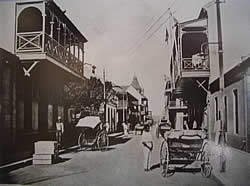
Lourenco Marques 1910 |
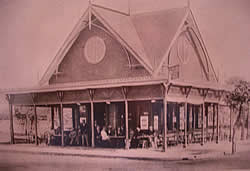
The Pyramid Kiosk |
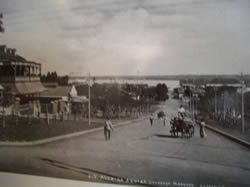
Avenida Aguiar |
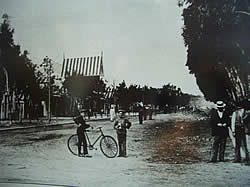
Avenida D. Carlos |
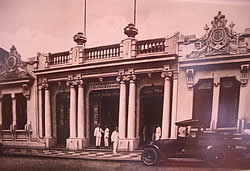
Banco Nacional Ultra Marino |
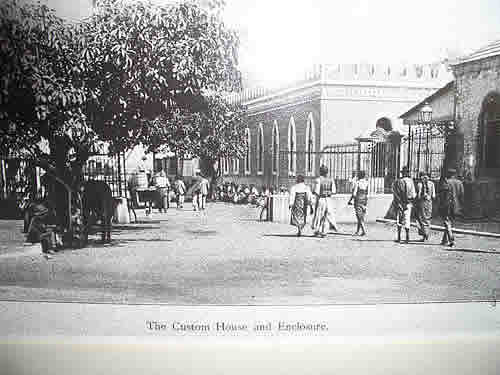
The Customs House
|
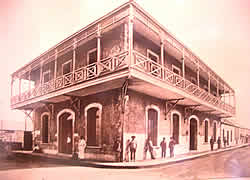
Hansen Schrader Building
|
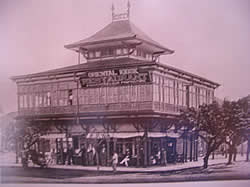
The Oriental Kiosk
|
|
|
|
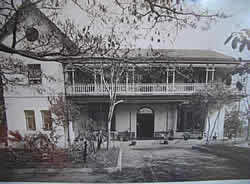
Hotel Cardosa |
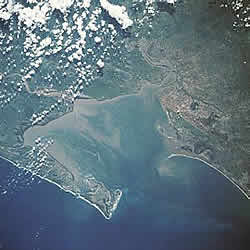
Maputo Bay Jan 1990
courtesy of Wikipedia.org |
|
|
|

